
By Shawndra Russell
have hearts of service. As Jeffrey Huffman, director of Military and Veteran Affairs at University of Central Missouri perfectly sums up, “Anecdotally, when you volunteer to join the military, you automatically have a service heart. You’re literally saying, ‘I’m willing to write a check up to and including my life, for my country.’”
Of course, that willingness to serve something larger than yourself comes with some costs. For example, the National Center for PTSD, part of the U.S. Department of Veterans Affairs, estimates that 30 percent of Vietnam veterans have had PTSD in their lifetime, as well as about 20 percent of those who have served in the more recent Iraq and Afghanistan wars. But organizations like VetsWork and Warrior Expeditions are helping veterans transition back into civilian life — with or without a PTSD diagnosis — and find a new way to serve and protect our country and its precious resources like the Appalachian Trail.
From top: UCM-Konnarock volunteers Fredy Velasquez, Jasmine Walker, and Rui Carvalho help to carry rock for stone step construction at the Big Butt to Jerry Cabin tread rehab project
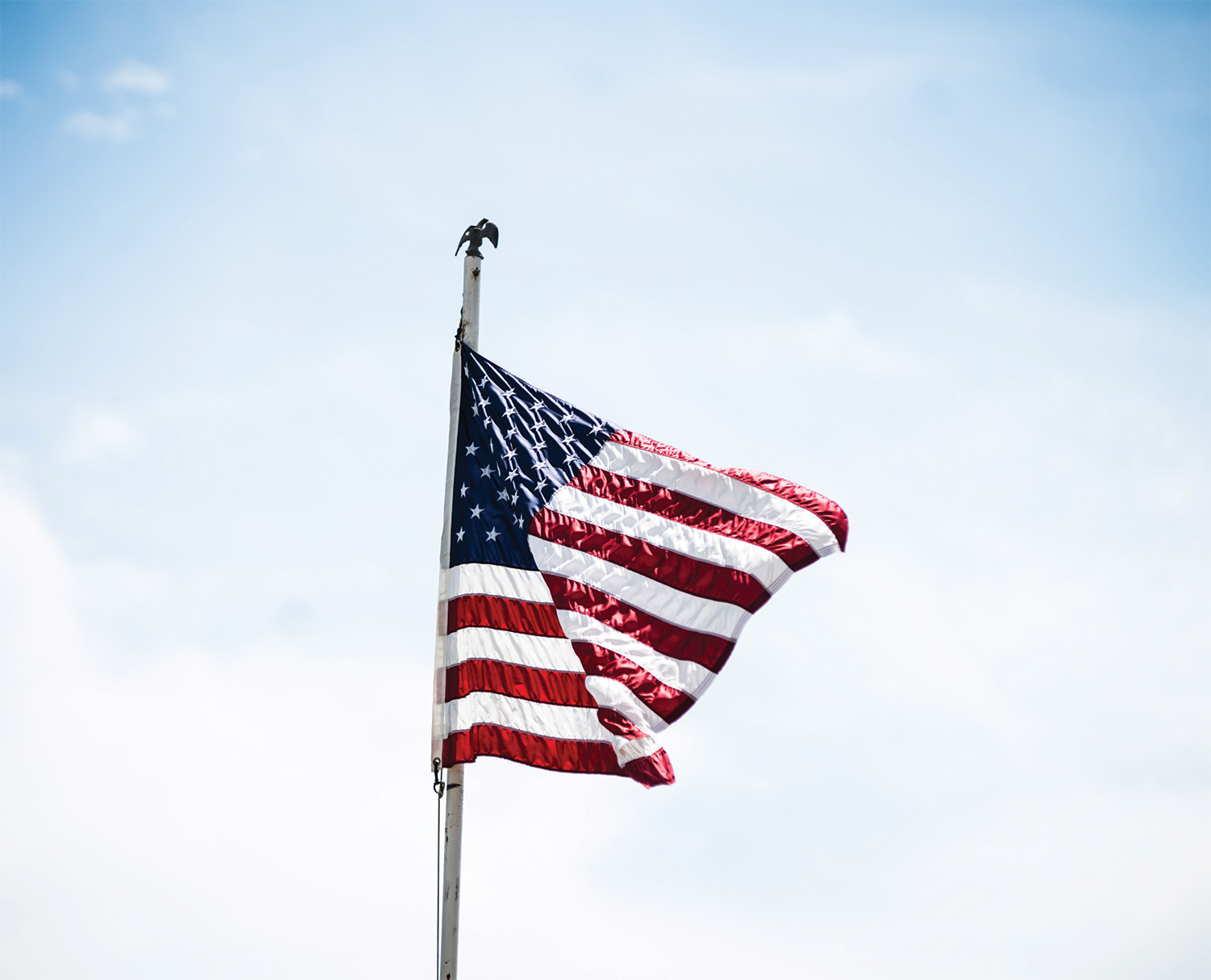
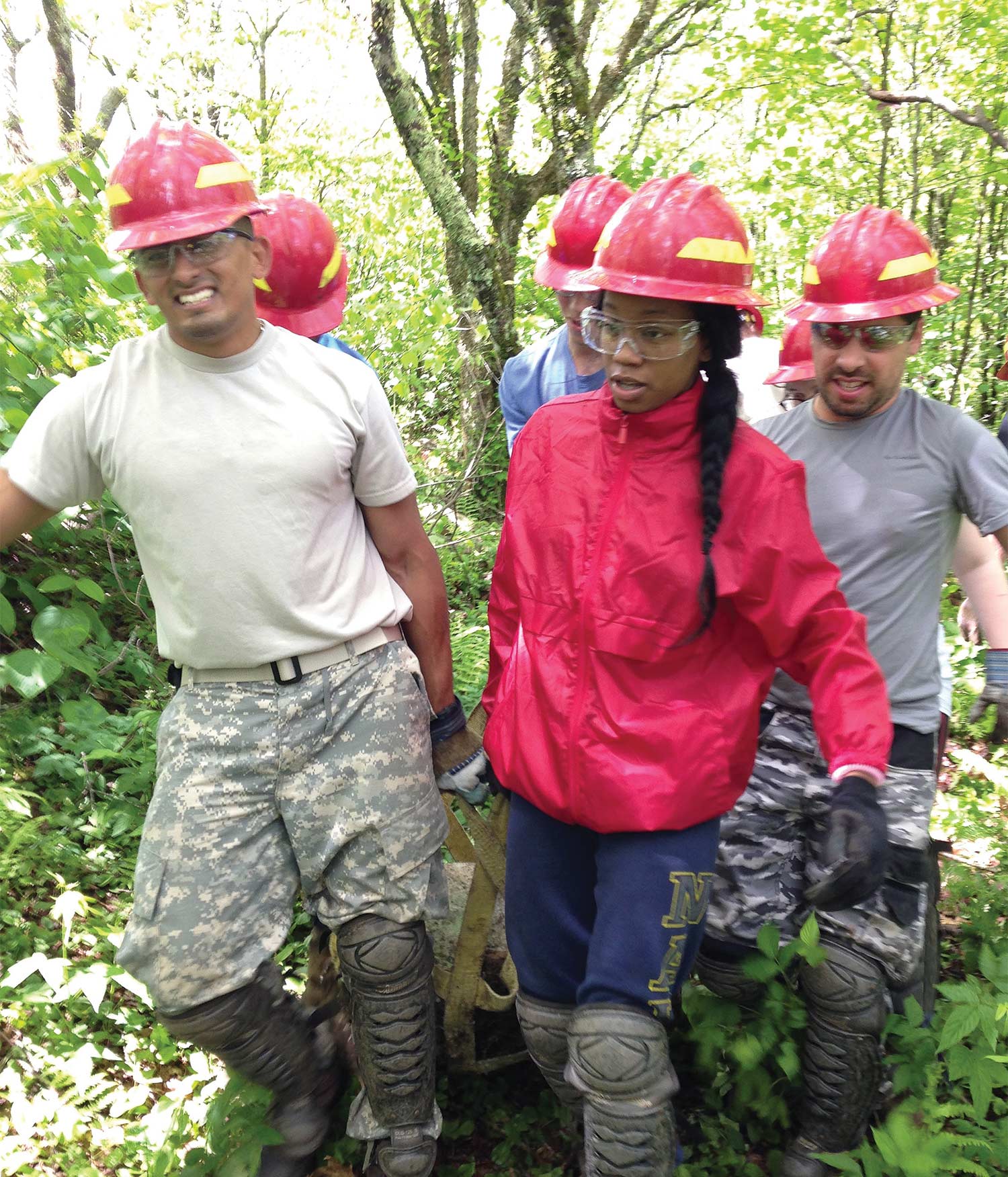

By Shawndra Russell
From left: UCM-Konnarock volunteers Fredy Velasquez, Jasmine Walker, and Rui Carvalho help to carry rock for stone step construction at the Big Butt to Jerry Cabin tread rehab project
have hearts of service. As Jeffrey Huffman, director of Military and Veteran Affairs at University of Central Missouri perfectly sums up, “Anecdotally, when you volunteer to join the military, you automatically have a service heart. You’re literally saying, ‘I’m willing to write a check up to and including my life, for my country.’”
Of course, that willingness to serve something larger than yourself comes with some costs. For example, the National Center for PTSD, part of the U.S. Department of Veterans Affairs, estimates that 30 percent of Vietnam veterans have had PTSD in their lifetime, as well as about 20 percent of those who have served in the more recent Iraq and Afghanistan wars. But organizations like VetsWork and Warrior Expeditions are helping veterans transition back into civilian life — with or without a PTSD diagnosis — and find a new way to serve and protect our country and its precious resources like the Appalachian Trail.
Nature certainly gives back more than just providing a similar sense of giving and serving that is part of veterans’ DNA. In fact, The Atlantic magazine recently reported that “nature-as-medical-treatment is catching on. ‘Ecotherapy’ is a burgeoning field, and some doctors even write prescriptions for time spent in parks.” The term “forest bathing” has also entered our vernacular, something practiced by the Japanese frequently for “simply being in nature, connecting with it through our senses of sight, hearing, taste, smell, and touch…by opening our senses, it bridges the gap between us and the natural world,” explains Dr. Qing Li, author of Forest Bathing: How Trees Can Help You Find Health and Happiness.
To tap into the healing power of nature, many veterans have opted to follow in the footsteps of Earl Shaffer, a World War II vet who famously said, “I’m going to walk off the war” before becoming the first person to hike the entire Appalachian Trail. Yet, many veterans step up to do much more than just hike the Trail; they now serve their country in a new way by volunteering to maintain and protect this amazing resource. Some monitor swaths of the Trail, while others join clean-up clubs and crews up and down the Trail’s 2,190 miles. And if Mr. Huffman gets his way, there’ll be university veterans’ departments at colleges across the country replicating the success he’s had in three years of signing up veteran students to serve on the Konnarock Trail Crew, the Appalachian Trail Conservancy’s (ATC) flagship Trail Crew program that started in 1983 near Damascus, Virginia.
“Often times, you’ll talk to someone who is a college graduate, and they’ll say ‘college was the best days of my life,’ but military-connected students don’t say that… I wanted to change that for my students — whose purpose is to give them one experience in college that they’ll reflect on,” Huffman explains. His approach certainly made a difference in Elizabeth Crawford’s life. An Air Force reservist, Crawford was one of the volunteers on Huffman’s first UCM Konnarock crew in 2016. But she wasn’t too keen on the idea when Huffman first approached her. “I’m not an outdoorsy kind of girl!” she exclaims. “I had never been camping in my life, let alone camping for a week in the middle of the mountains with a group of burly ex-military men. [But] I made lifelong friends. I shared some really great experiences, laughs, cries, and made some amazing memories with some wonderful people.” Today, she and her “Trail buddy” — a.k.a. “the two slowest hikers up the mountain every day,” Elizabeth says — have become even closer friends. “We’ve been there for each other through some really wonderful (and really tough) moments in each other’s lives. I never would have had that friendship if it weren’t for the A.T.” The Trail also impacted Elizabeth’s choice for graduate school, Appalachian State, and inspired her to plan her own long trek on the Trail.
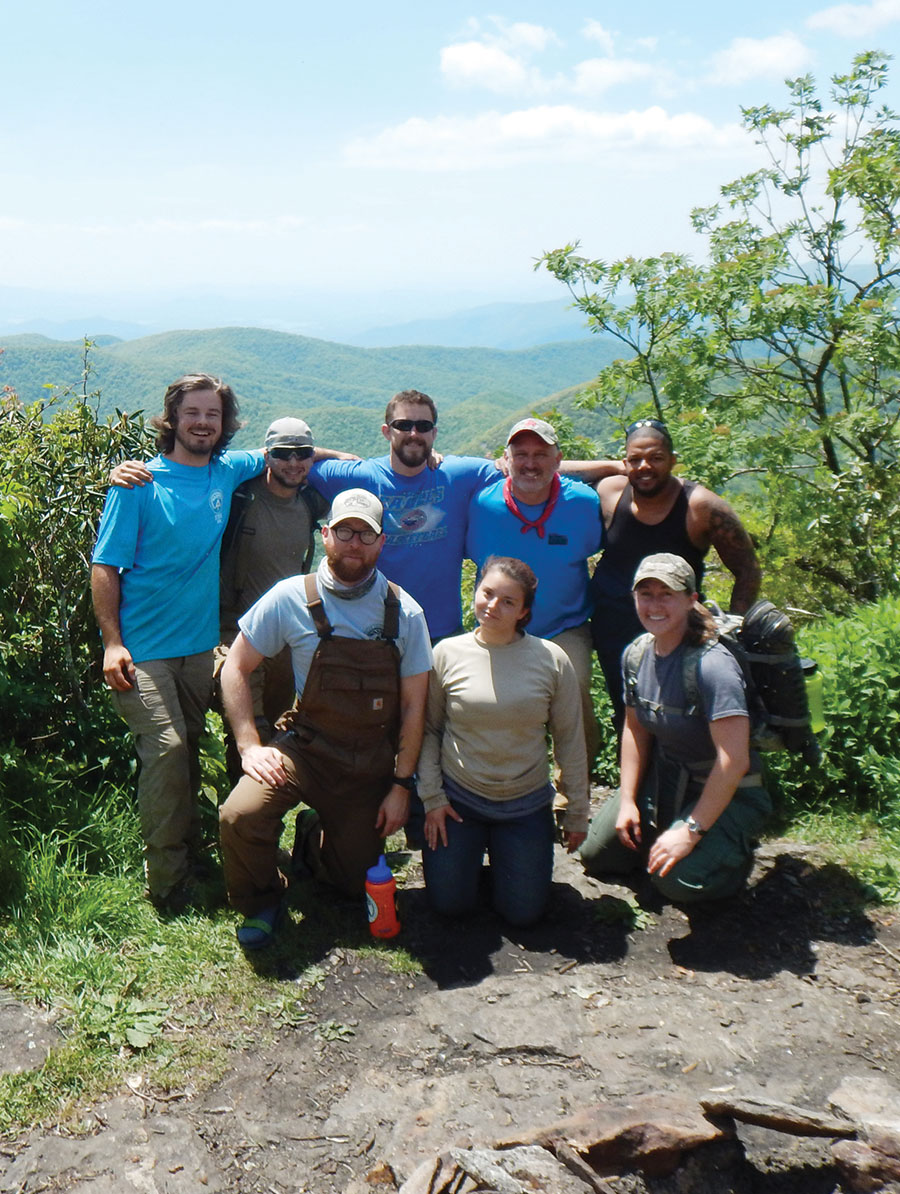
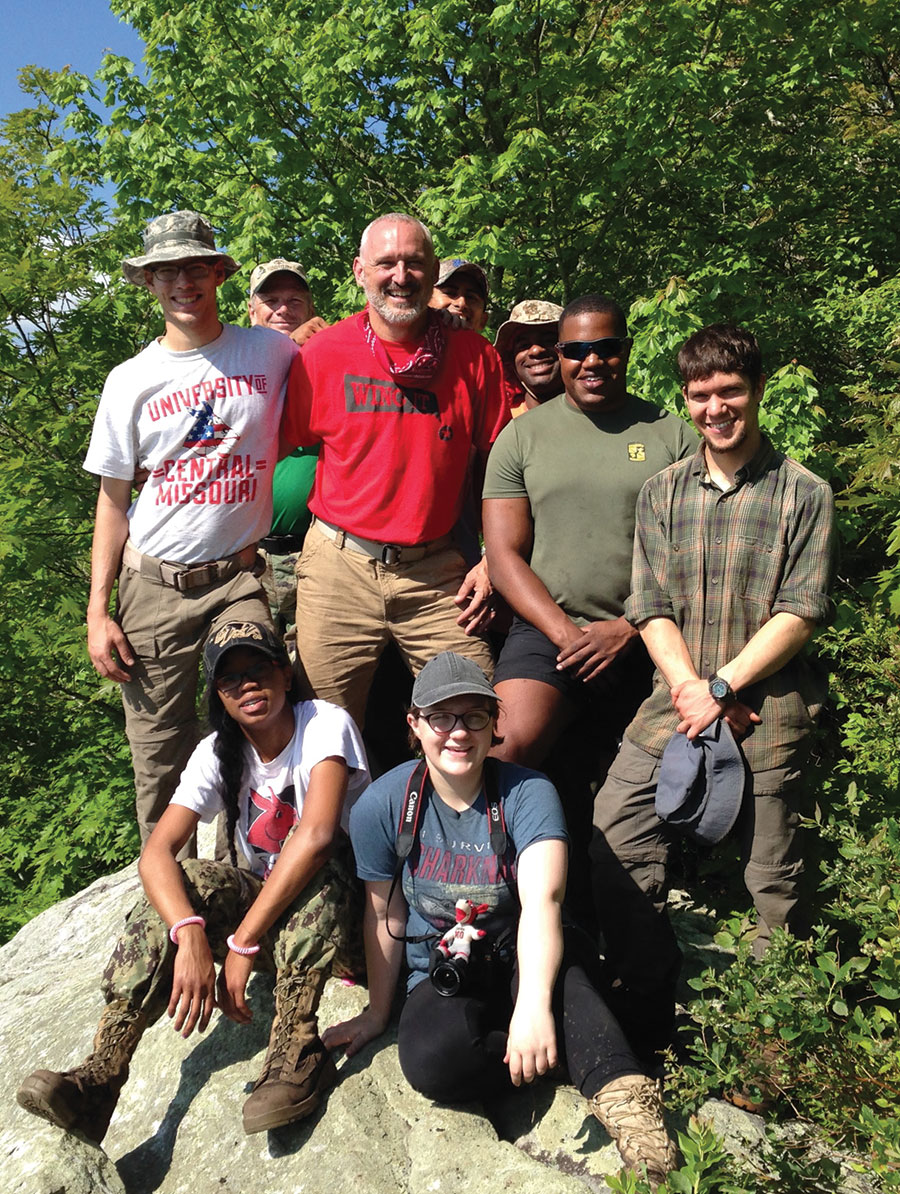
From top: (back row from left) Konnarock Crew leader Justin Farrell with UCM volunteers Ian Powers, Galen Livingston, Jeff Huffman (UCM’s director of Military and Veteran affairs), Michael Carle, (front row from left) Christopher Stockdale, Elizabeth Crawford, Kaitlyn Lowe at the Standing Indian tread rehab project in North Carolina; (front row from left) UCM volunteers Jazmine Walker, Kalyla Hayden (second row) Jacob Angevine, Jeff Huffman, Ben Boyd, Josh Reynolds (Konnarock staff), (back row) Jerry Kyle (Konnarock staff), Fredy Velasquez, and Tyrone Ritter at the Big Butt to Jerry Cabin rehab project
Huffman’s approach helps forge strong bonds between the crews, and they have a reunion campout every year and invite all the volunteers from each year to come back and reflect on their Konnarock experience. “Every person that’s ever been has commented on how it’s changed their life,” Huffman says proudly. However, the experience is about more than just making memories and making new friends. Huffman has teamed up with fellow UCM professor Christopher Stockdale to create “a service learning in-a-box” approach. “It doesn’t necessarily have to be on the Konnarock Trail Crew scale,” Huffman says. In fact, Huffman is starting up weekend trips to help with the Ozark trail so that more students can experience the benefits of what he describes as “teaching the value of service and the value of the life-changing components of serving others over time.” To drive this mission home, Huffman requires his crews to participate in a nightly reflection and complete six 90-minute sessions before the trip to educate them about the difference between service and service learning.
The other big result Huffman has noted is that the trips “help address some of the issues related to PTSD and relating to military transition into the civilian world.” As an experiment this year, Huffman invited 10 military-connected students and 10 non-military to help break down cultural stereotypes and said the result was “phenomenal. It was amazing to hear the traditional students talking about the military folks and their appreciation for them now. Several of the non-military students come hang out in our center now; that never happened before.” Going forward, they will continue to create a mix of crews while offering some military-only volunteer opportunities, as well.
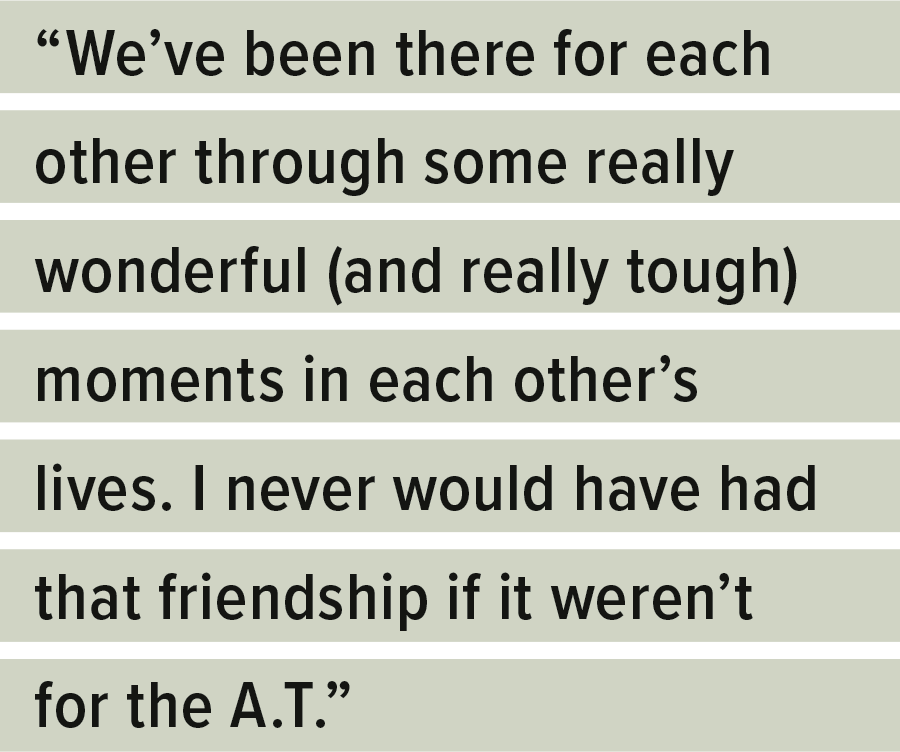
Josh Kloehn, resource manager for the ATC, is certainly grateful for Huffman’s efforts and those of his rotating cast of student veterans that come out for a week of work each year with the Konnarock Trail Crew, or K-Rock crew. “After a few years of him bringing 10 volunteers and it being wildly successful, I had no hesitation that they’d be able to fill 20 spots with energetic, hard-working, and dedicated UCM volunteers,” Kloehn explains. He attributes part of the success with the preparation that Huffman and his colleague Chris Stockdale give to the volunteers, but points out that “for the UCM groups, it’s not just working hard out in the woods, it’s applying the hard work, living together for several days out in the woods, working closely as a team — this intense Trail crew experience echoes some of their military experience.”
Joseph Phillips, retired U.S. Army soldier and Military Attaché for arms control issues at the U.S. Embassy in Moscow, agrees that his military service and volunteer work for the Maine A.T. Club share similarities. “Both are services for a worthy cause to the benefit of society as a whole, and the quality of service rendered in both cases is largely dependent on the individual,” he says. Philips monitors a 10-mile boundary in Maine (quite the undertaking) and his interest in the A.T. started when he was young after an older cousin thru-hiked many years ago. “I’ve wanted to thru-hike since then, but life hasn’t allowed me the opportunity yet. This seemed like a way to get a little more familiar with the Trail and the communities surrounding it,” he explains.
For former helicopter pilot Patty Pender, volunteering for the past 14 years on the Konnarock Trail Crew has created many special memories: “I love the camaraderie and meeting such interesting people. The staff and crew leaders make the experience worth coming back for year after year.” Now, as a Physical Education teacher, she regularly teaches her students the importance of serving. “It broadens their knowledge of themselves and the world. It forces you to be less self-centered,” she adds. And like serving in the military, Pender says her volunteer work on the A.T. allows her to fulfill her desire to “do something for the betterment of others.”
Being part of something bigger is a common theme that emerges from talking with vets who’ve volunteered on the A.T. “Lots of folks worked hard over the decades to make the Trail so great. I respect that,” explains Travis Stanley, who volunteered with the Mount Rogers A.T. Club after his VetsWork internship ended at Mount Adams Institute. His experience led him to study parks tourism and recreation management at the University of Montana with a minor in nonprofit administration. He might even come back to southwestern Virginia post-graduation to “improve the economy with a sustainable business related to adventure tourism.” Now, he continues to give back to the environment as part of the Montana Conservation Corps.
Clearly, the A.T. has enchanted many veterans, including retired Navy Supply Corps officer Ned Kuhns who has volunteered with the Tidewater Appalachian Trail Club (TATC) in Norfolk, Virginia for 27 years. “By being a member of TATC, I have gained many interesting and talented friends with whom to share outdoor recreational experiences, such as hiking, backpacking, canoeing, kayaking, cycling as well as social gatherings. Military veterans have much to offer organizations and have much to gain personally by volunteering to take on leadership positions in the ATC clubs and regional organizations,” he advises. And after 12 years of volunteering on the Trail, Kuhns got to mark something else off his bucket list: completing his A.T. thru-hike. “Seeing all the state sections of the A.T. and wanting to ‘give something back’ just reinforced my desire to continue contributing as a volunteer with TATC,” he says.
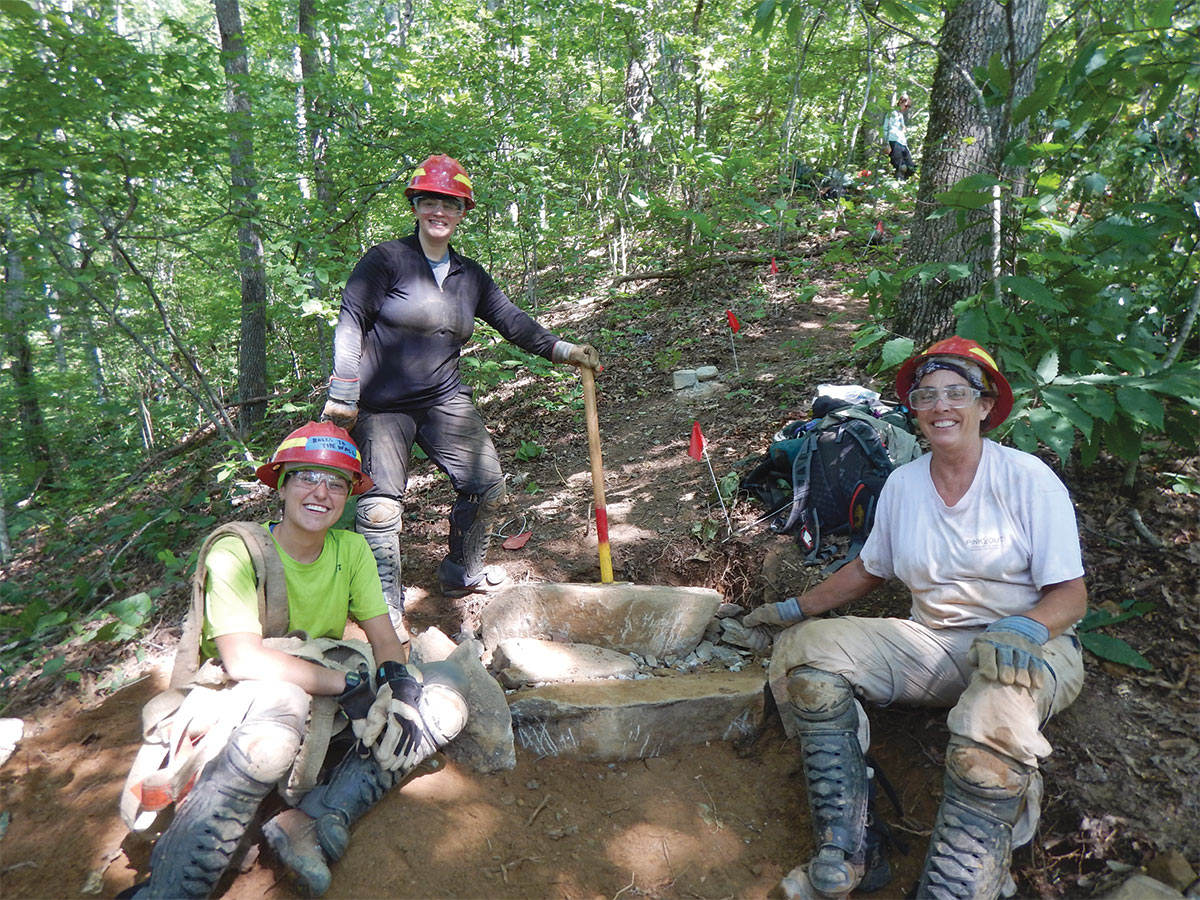
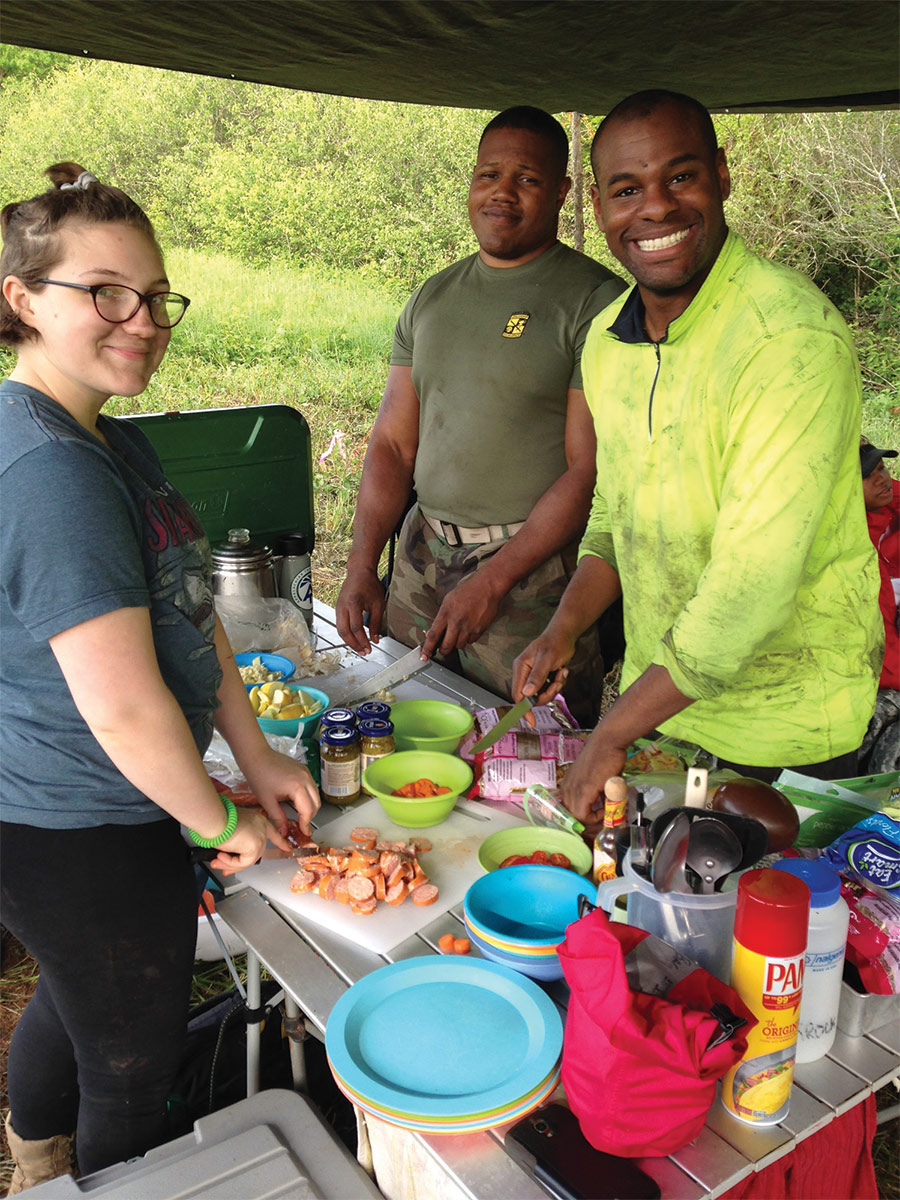
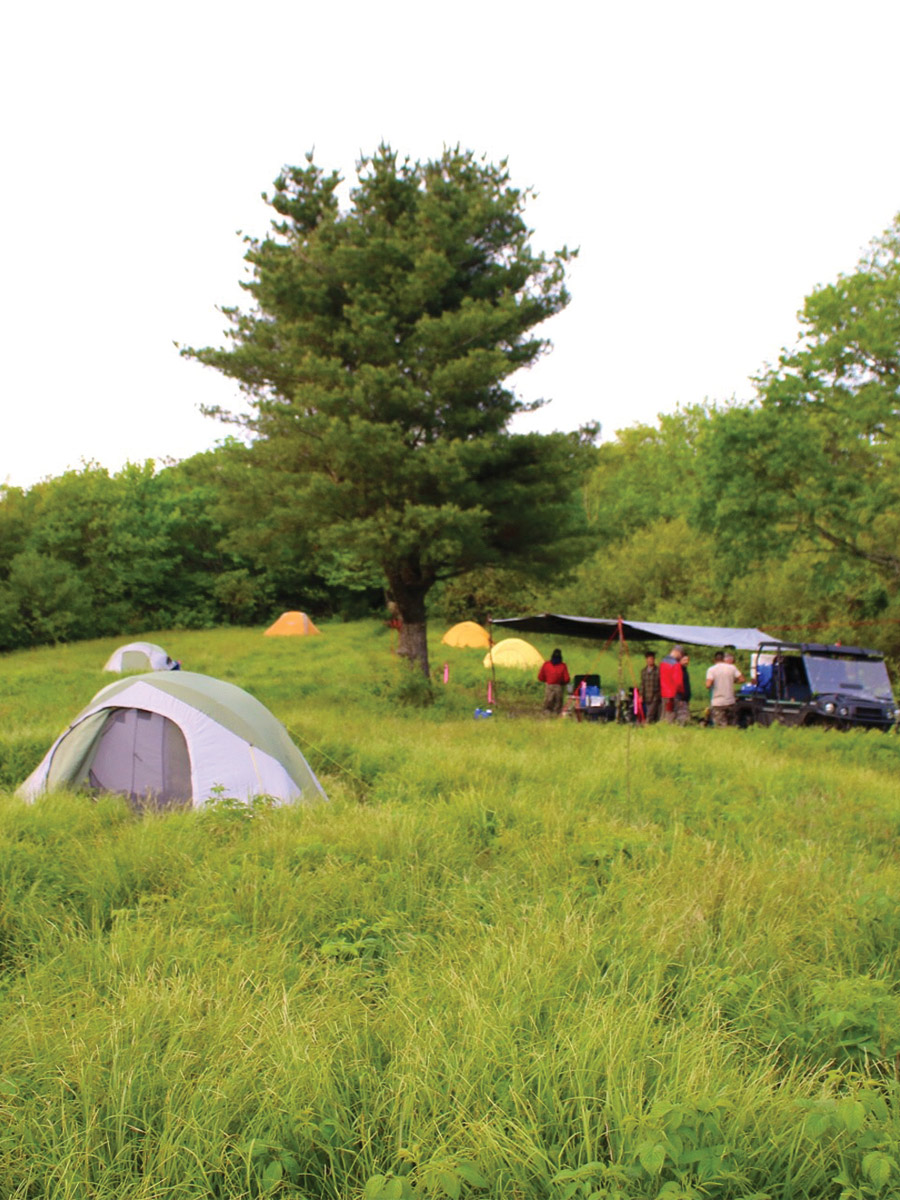
Clockwise from top: UCM volunteers Kelsey Smith, Katherine Kavouras, and Patty Pender show off their newly constructed rock steps on the Brown Fork Gap relocation project in North Carolina; Konnarock Crew sets up camp for the North Carolina/Tennessee Big Butt to Jerry Cabin tread rehab project; UCM volunteers prep for dinner at camp (from left) Kayla Hayden, Ben Boyd, and Tyrone Ritter
Kuhns explains that his experience as a Navy Supply Corps officer helped during his time as president of TATC as he could “share my leadership and technical knowledge to other TATC members to hopefully make the club a better organization.” He points out that both the military and the A.T. rely on volunteers who want to protect our wonderful country and its resources, so “joining ATC after military service is a natural way to continue serving for the public good.” Lamar Powell, a member of the Smoky Mountains Hiking Club and U.S. Army veteran, couldn’t agree more. “There is a ‘mission first’ mentality in the military, and I think this is common among maintainers,” he says, adding, “Belonging to a Trail crew is to belong to something far, far greater than one’s own self.”
The history of the Trail also keeps Powell motivated to continue volunteering into his 70s. “I know of certain sections of the A.T. that are some of the original pathway. Earl Shaffer and Dorothy Laker, Myron Avery, and Grandma Gatewood all passed over those very places. I have stood there and mused, ‘I am here, this place is here because others have gone before me.’ I owe a debt to hikers I have never known,” he shares. But really, his continued volunteerism stems from one simple reality: “It’s just fun to be on a crew. Banter is fun, so is achievement and making new friends.”
Powell’s pride for the Trail is evident, too. “The ATC and other organizations and agencies have invested great effort in devising techniques and practices that are now yielding a trail that is the standard for the rest of the world. This is no exaggeration. In the 22 years that I’ve been involved, I’ve had the pleasure of serving with others from 31 of our states and 14 other countries. I’ve served with folks from Israel, Spain, and Taiwan who were sent by their governments to learn ‘trail’ [maintenance] from the ATC crews,” he explains. This gold standard has earned the A.T. status as one of the world’s best thru-hikes with Popluar Mechanics magazine saying earlier this year that it “may be the best long-distance hiking route in the entire world.” The ATC’s program director for volunteer relations Leanna Joyner explains that volunteerism is a key to the Trail’s success. “I think about the altruism of both military service to the cause of something bigger and the service of those who care for the A.T. — this really big idea that happens only because people step up to make it happen and dedicate themselves to it,” she says. “The sense of community that people gain from hiking on the Trail or volunteering for the common cause is equally important. There’s also the sense of satisfaction of a job well done and producing something meaningful that leaves a legacy.”
Sean Gobin, founder and executive director of Warrior Expeditions, adds more appreciation for the ATC as their partnership led to his organization’s first trip in 2013. Gobin actually thru-hiked the A.T. immediately after completing his 12 years as a Marine and got the idea to start these outdoor expeditions for veterans during his 4.5-month trek. “The Marines didn’t have a transition program in place, and we were quickly rushed through the process — really it was just a powerpoint — so I checked out of base, grabbed some gear, and drove straight to Springer Mountain. While on it, I started to realize that it was a very powerful, therapeutic experience,” Gobin says.
And although he didn’t know about Shaffer before his hike, he quickly learned about him upon his return after speaking with some of Warrior Expeditions’ now board members. “They wanted to be part of our programs to honor Earl,” and Shaffer’s story sits proudly on the nonprofit’s homepage. Today, Warrior Expeditions has grown into 10 different expeditions: eight long-distance hiking experiences, a long-distance bike ride along the TransAmerica Trail, and a paddling trip down the Mississippi River.
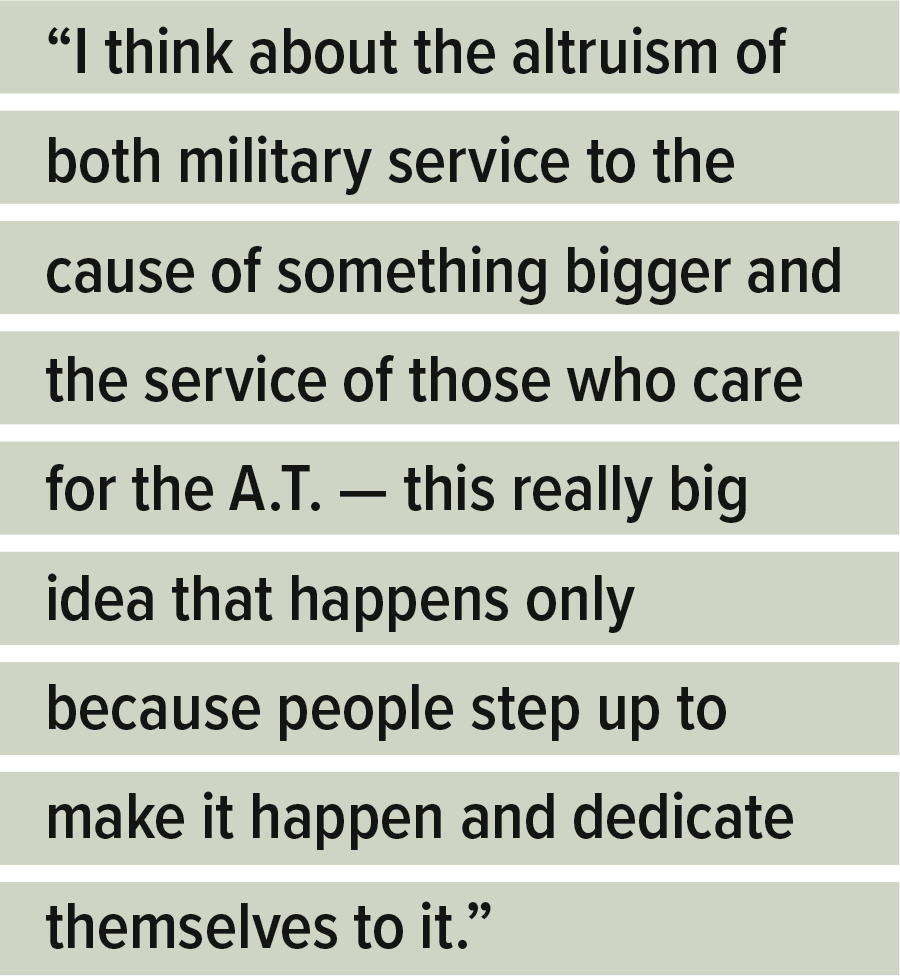
Gobin obviously struck on a growing need, and their good work earned Warrior Expeditions the CNN Hero Award in 2015, which helped increase interest in their programs. “It really got the word out to a lot of vets who need the opportunity to find peace and healing in nature,” he says. Yet, the most important reward for Gobin and his team is seeing embattled veterans struggling with cynical views, depression, or thoughts of suicide, regaining their trust in humanity. “As a vet, you’re witnessing the worst that humanity has to offer. You have to break that cycle, so the community support we have along the trails reinforces that people are inherently good.” These veteran volunteers sure are, and we owe them continued gratitude for everything they’ve given for our country and for how they continue to give.
For more information or to join a Trail Crew visit: appalachiantrail.org/crews
Watch myATstory – “All the Way” about one veteran’s connection to the Appalachian Trail.
In 2013, Vietnam War veteran Don “All the Way” Lenc began a thru-hike of the A.T. In the face of the physical and emotional challenges — and even a broken arm — Don was able to find something beautiful: a sense of peace.
Visit the Appalachian Trail Veteran Association Facebook group, led by Jonathan Quigley, to connect with veterans across the Trail at: facebook.com/groups/ATforVets